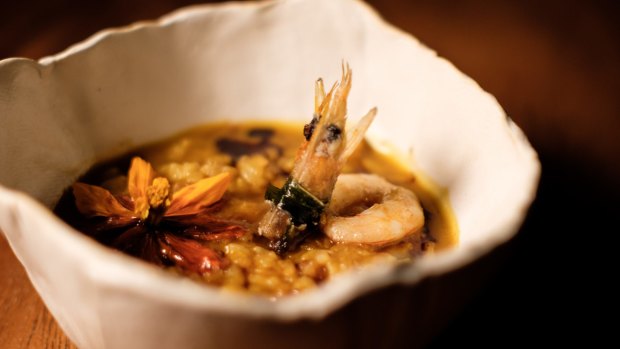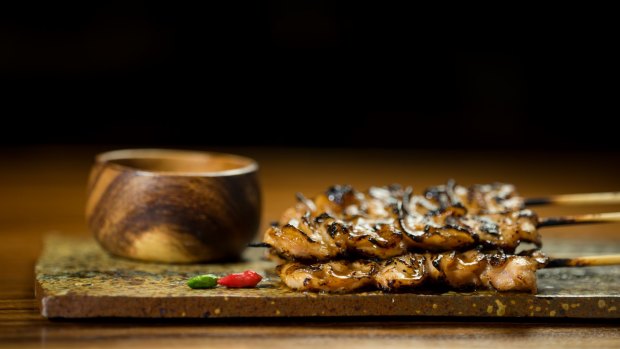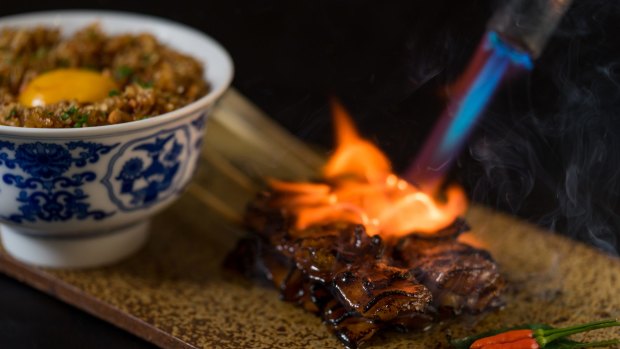This was published 5 years ago
Food, Philippines: Where to find the world's hottest new cuisine
By Susan Skelly

Toyo Eatery.Credit: Toyo Eatery
Filipino food might not be as popular as Thai, Vietnamese or Indian cuisine, but two very different food experiences in Manila, New York and on board Silversea's Silver Muse suggest there's a revolution under way.
First, a degustation menu at Toyo Eatery, which debuted on Asia's 50 Best Restaurants list this year. Chef Jordy Navarra, who has worked at The Fat Duck in Britain and Hong Kong's Bo Innovation, opened Toyo in 2016 and cemented his cultural credentials with a dish that combined the 18 vegetables mentioned in the Tagalog children's song Bahay Kubo.
Today, his team sends out runway-chic "snacks" that play with tradition. There's kinilaw (slivers of raw clam marinated in vinegar, nesting in purple seaweed) and the Philippines' signature barbecue, a skewer of paper-thin pork from each of shoulder, belly and rump. The cocktail menu is a hipster crowd magnet.

Three-Cut Pork BBQ at Toyo Eatery in Manila.Credit: Toyo Eatery
Then there's the other book-end, the kamayan feast that Filipina-American chef Nicole Ponseca has made famous in New York with her restaurant Jeepney, a rambunctious sister to her award-winning East Village eatery Maharlika.
Her kamayan feast looks like an art-installation version of medieval gluttony – wall-to-wall food to be eaten with your hands. There are roast chickens, skins made glossy with a marinade of mashed banana, soy sauce and garlic; stuffed squid draped over bamboo scaffolding; prawns as big as lobsters; salted eggs in shells dyed purple; bunches of tiny sea grapes. It's primal and just a little bit thrilling.
In her book, with chef Miguel Trinidad, I Am A Filipino And This Is How We Cook, Ponseca explains Jeepney's genesis.

A three-cut pork barbecue at Toyo Eatery in Manila.Credit: Toyo Eatery
"We reimagined kamayan as a table-length feast with no plates or silverware, just a spread of aromatic, flame-kissed banana leaves laid out with a pile of perfect white rice mounded high with juicy longanisa sausages; head-on jumbo shrimp cooked in adobo; a whole fried fish topped with vinegar-pickled peppers called escabeche plus fresh cucumber salad dressed in sugarcane vinegar and patis."
Her cookbook has been named best cookbook of the year by publications including The New Yorker and The Los Angeles Times, and in March it was shortlisted in the International Cookbook category of the 2019 James Beard Awards. Ponseca joined three more nominated Filipino-American chefs: Tom Cunanan (winner in Best Chef: Mid-Atlantic category), Margarita Manzke and Sheldon Simeon. .
"Filipino food is having its light bulb moment," Ponseca says. "We are realising that we can be ourselves, and it's a huge revelation. After so many colonisers, so much eradication of our culture, we are beginning finally to reach down deep to reclaim our traditions.
"Jordy Narvarra is elevating our culture in a way that's never been seen before. And a book like mine is one of the first to dissect politics, customs and food. I'm just connecting dots that have not been connected."
I meet Ponseca on board Silversea's Silver Muse, cruising from Manila to Singapore via Coron in the Philippines' Parawan province in the South China Sea, and Kota Kinabalu, the capital of Sabah in Malaysian Borneo. The cruise line is road-testing a new food concept called S.A.L.T. (Sea and Land Taste) to be introduced on Silver Moon, which launches in August 2020. The program aims to match food with the ports the ship visits, embracing each location's people, history, culture and politics.
During the cruise Ponseca – who grew up in the US, her father in the military, her mother a nurse – demonstrates three of the most popular dishes. A kinilaw of cured tiger shrimp cooked in "liquid fire" – usually citrus or one of myriad vinegars; adobong manok, a classic chicken adobo with a silky, fatty, sour sauce; and burong isda, cooked rice fermented with layers of salted raw fish.
Filipino food is influenced by China, India, Arabia, Spain and America. In many ways it is as resourceful as Manila's jeepneys, those vehicles left behind by American soldiers after World War II and repurposed in many creative ways.
"Filipino cuisine is as rich and diverse as the more than 175 languages and dialects spoken in the Philippines, across its 7000 islands," says Ponseca. That brings a complexity of flavours: pungent, unctuous, funky, highly acidic and coyly sweet. The "funk" Ponseca so loves is what fish sauce and seafood paste, or bagoong, bring to the table. She also can't help proselytising about pansit (noodle dishes), pandesal (yeasty rolls), pata (crisp fried pork hock), humba (braised pork belly), and her favourite Filipino dish, kare kare (a slow-cooked oxtail casserole with an insane creamy peanut butter sauce).
An appreciative diner – the Pulitzer-Prize winning journalist Jose Antonio Vargas – once asked Ponseca why she opened her restaurant, Maharlika. She replied: "I wanted to change the conversation about Filipino food."
TRIP NOTES
Susan Skelly travelled as a guest of Silversea and Qantas.
MORE
CRUISE
Silversea's new food concept called S.A.L.T. (Sea and Land Taste) is to be introduced on Silver Moon, which launches in August 2020. A berth aboard Silver Moon will start at $7500 a person for a seven-day cruise. See silversea.com
FLY
Qantas operates direct flights to Manila five days a week. See qantas.com
Sign up for the Traveller Deals newsletter
Get exclusive travel deals delivered straight to your inbox. Sign up now.